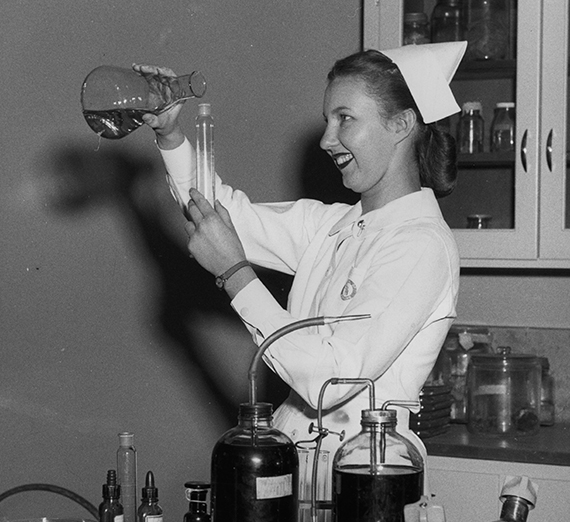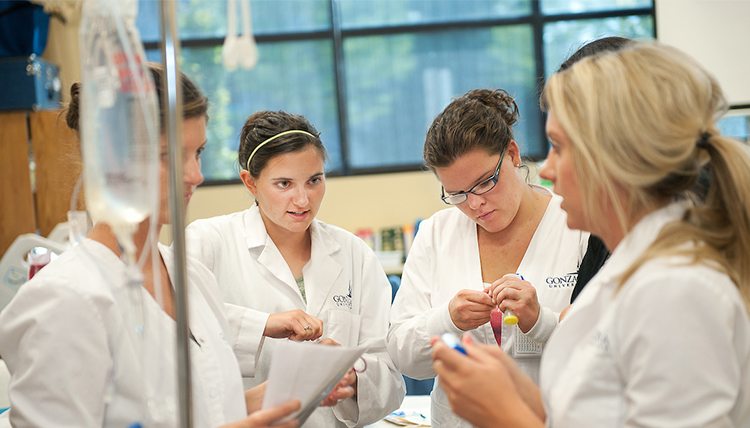Then & Now: The Evolution of Health Sciences

Colleen Shannon recalls standing in front of the TV at her ironing board, with iron on one end and notepad and pen on the other.
She was watching a videotaped lecture sent to her by the Department of Nursing while earning a Master of Science in Nursing in 1997.
The program sought to reach practicing nurses in underserved areas of the country and the world – her class of 17 had folks from China, Mexico, Oregon, Idaho, Montana and western Washington – where they might be the only health care providers and unable to leave their small communities to complete advanced degrees.
While Shannon offers high praise for the program and its accommodating delivery, she found herself wanting to raise her hand and ask questions, yelling at the TV.
The delivery system has upgraded from VHS tapes and CD exchanges to Blackboard and Canvas learning systems, but the heart of the program remains rooted in the Jesuit trademark cura personalis, care for the whole person, says Julie Wolter, dean of the School of Health Sciences.
Today, health science education continues to increase enrollment across the board, from the School of Education’s physical education tracks in kinesiology and fitness to the College of Arts and Sciences’ pre-health career curriculums. Multiple tracks in the newly named School of Health Sciences, replacing the former School of Nursing and Human Physiology, include broader opportunities, including public health, and a stronger presence in the University of Washington School of Medicine-Gonzaga University Health Partnership, where possibilities continue to grow for students to conduct research and study alongside UW medical students.

In addition, in 2020, pre-health advising moved from professors in biology and chemistry to the Career and Professional Development’s fairly new Health Professions Pathways Program (H3P).
Pre-med/pre-health advising previously focused on faculty providing letters of recommendation for candidates applying primarily to medical and dental school, says H3P’s Katherine Brackmann, co- chair of the endeavor with Kevin Measor, who teaches for Gonzaga and the UW medical school. Now, H3P supports students on career discernment, understanding admission requirements and application processes for degrees in medical, dental, pharmacy, physical therapy, occupational therapy, accelerated nursing, optometry, physician assistant and more.
Looking Ahead
A bachelor’s degree in public health will launch in Fall 2024, with a master’s expected to unfold in Fall 2025, Wolter says. The University is studying the feasibility of other programs as well, relying on input from stakeholders during the coming year to help set a direction.
“We see great need for advancements in rural communities with health care shortages in nursing, rehabilitation and mental health,” Wolter says. “We are assessing the most immediate needs and looking at longer-term goals to expand what we do to serve our region.”
A far reach from those early days exchanging VHS tapes.
Changing with the Times
While no official records chronicle the evolution of health sciences at Gonzaga, here’s a brief overview:
1930s and ’40s – A few doctors and dentists, who likely majored in sciences, make it to their career destinations
1940s – Students at St. Luke’s and Sacred Heart nursing schools come to Gonzaga to earn their bachelor’s degrees
Late 1970s, early ’80s – Chemistry Professor Kay Nakamaye and Biology Professor Robert Prusch push for advanced curriculum updates and form the Committee on Health Science Careers, yielding a boost in enrollment
1978 – Department of Nursing founded under the College of Arts and Sciences, then moves to the School of Professional Studies
Late 1970s – School of Education partners with biology to create exercise science/pre-physical therapy track
2009 – Human Physiology degree evolves from exercise program
2013 – Nursing and Human Physiology become a school 2016 – UW School of Medicine-Gonzaga University Health Partnership forms
2023 – School of Nursing and Human Physiology expands to include public health; renamed School of Health Sciences
Care Goes Both Ways
Amy Moran (’01) always thought she wanted to be a medical doctor, and took a pre-med curriculum, graduating in biology. But a Murdock summer research scholarship and subsequent work in Professor Mia Bertagnolli’s biology lab as a Murdock Fellow introduced her to medical research as a possible career.
Four years as a technician in Bertagnolli’s sister- in-law’s lab at Harvard’s Brigham and Women Hospital in Boston, and a doctorate in immunology and cancer biology from the University of Minnesota, were steps in landing at Oregon Health and Sciences University, where today she is associate professor, runs a cancer research lab and hosts GU undergraduate students in her summer internship program. Her husband, Ryan Chaquette (’00), also pre-med at GU, married his love of medicine and his passion for business following an M.B.A. and master’s in health administration and is a hospital administrator at OHSU’s Doernbecher Children’s Hospital in Portland.
Meanwhile, David Dowd was a hospital nurse manager earning his Doctor of Nursing Practice degree from GU when COVID-19 hit in 2020, and he had 115 caregivers seeking his direction.
“I was overwhelmed,” Dowd says. “But I was blessed with an amazing interim dean, Lin Murphy, who called and asked how she could help.
“Not only did the D.N.P. program teach me how to be an effective change agent in health care, it taught me how to be a servant leader. I witnessed the Jesuit values being actively demonstrated by my professors,” Dowd recalls.
Enrollment Today
- 455 biology, chemistry or biochemistry majors
- 876 students declaring an interest in pre- health sciences
- 220 human physiology majors
- 370 undergraduates, 414 graduate students and 51 doctoral students in nursing
